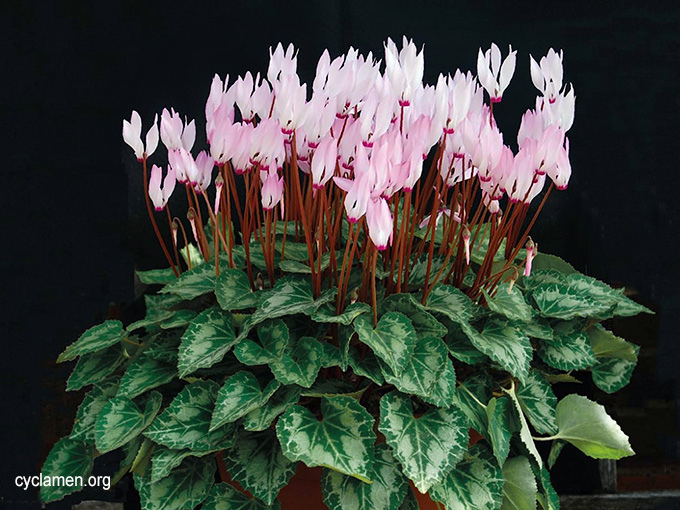Description
Flowers appear from autumn to late spring, in the wild from October to January (var autumnale), dependent on the start of the autumn rains, or December to May (var persicum), from white to deep carmine with a darker pink, magenta or purple area all around the mouth of the corolla but a wild pure white (forma albidum) is known, very fragrant. Corolla lobes reflexed, 20-45mm long, 7-20mm wide, with pointed tips and highly twisted, sometimes more than 360 degrees, no auricles at the base. Unusually among cyclamen, after fertilisation the flower stalk bends back toward the ground at the base of the plant rather than coiling from the top as in most species.
Leaves appear as soon as there is regular water, well developed by flowering time, arising straight up from the tuber, broadly oval, fleshy with thickened edges and teeth, extremely variably patterned in shades of green, grey or silver on a green ground, underside purplish, 2-19cm long, 2-15cm wide.
Tuber
Tuber a compressed sphere, large when mature, up to 15cm diameter, brown, becoming rough with age, thick (2mm) diameter roots arise all over the base.
Distribution
Cyclamen persicum grows in north Africa, the eastern Aegean and the northeast corner of the Mediterranean and is found in Algeria, Tunisia; eastern Crete, Karpathos, Rhodes, Symi, Chios and mainland Turkey in the eastern Aegean; Cyprus, and from mainland Turkey (again) through Syria, Lebanon, Israel and into Jordan in the northeast corner of the Mediterranean.
Habitat
Cyclamen persicum grows in a typically Mediterranean climate with hot dry summers and warm wet winters, from sea level to 1200m, mainly in open situations, in terra rossa over limestone, often in water worn pockets or crevices in bare rock but also under scrub or in old olive groves.
Cultivation
Cyclamen persicum is a tender plant, so not for outside in northwest Europe, where it is best cultivated in a frost-free greenhouse. The patterned foliage and highly scented flowers make it a good pot plant. The tuber is often planted with the top above the compost to avoid rotting of the leaves and flowers.

C. persicum var. persicum forma albidum.

White and pink flowered forms growing together around Latrun Monastery, Israel.

C. persicum var. persicum forma puniceum.
There are four distinct forms distinguishable by flower colour.
C. persicum var. persicum f. persicum – white flowers with a marked magenta or purple nose.
C. persicum var. persicum f. roseum – pink or carmine flowers with a marked magenta or purple nose.
C. persicum var. persicum f. puniceum – all-over magenta flowers often described as cerise with little or no colour variation between the nose of the flower and the remainder of the petal.
C. persicum var. persicum f. albidum. – flowers entirely white with no coloured nose; known in the past and reintroduced from Israel by The Cyclamen Society.

C. persicum var. autumnale
Galilee, Israel.

C. persicum var. autumnale
Mount Carmel, Israel.

C. persicum var. autumnale Mount Carmel, Israel.
Cyclamen persicum var. autumnale is the autumn-flowering variant that is found on either side of the Jordan Valley in Israel and Jordan, and in Lebanon to the south-southeast of Beirut. If flowers from October to January and generally has pale pink flowers with a magenta nose that are somewhat smaller than in var. persicum and often appears before the leaves.












